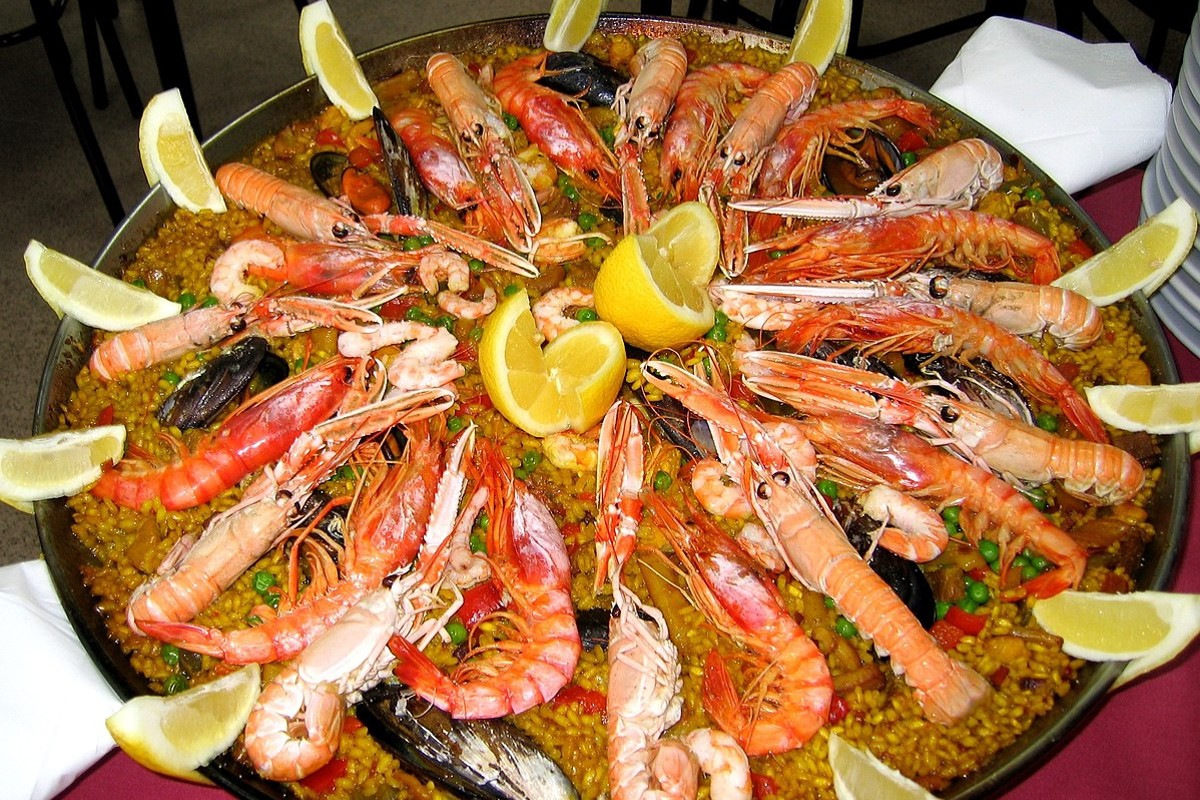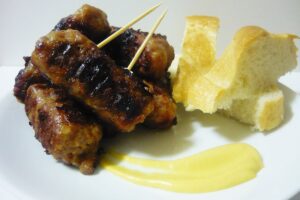Embark on a culinary adventure through Spain with this guide to traditional Spanish food. From hearty stews to vibrant rice dishes, Spanish cuisine is a reflection of its rich history, diverse regions, and abundant fresh ingredients. Discover the authentic flavors of Spain through these classic dishes and find the best restaurants to experience them.
1. Paella Valenciana: Spain’s Iconic Rice Dish
Paella Valenciana, a symbol of Spanish gastronomy, originated in the Valencia region. This saffron-infused rice dish features a medley of meats (often chicken and rabbit), vegetables, and sometimes seafood. The key to its unique flavor lies in the socarrat, a crispy layer of rice at the bottom of the pan.
- Key Ingredients: Bomba rice, saffron, chicken, rabbit, green beans, butter beans, tomatoes, rosemary, garlic, olive oil.
- Recipe: https://thyme-and-envy.com/recipe/2012/12/27/paella-valenciana
- Where to Try: Restaurant Levante in Valencia is renowned for its traditional wood-fired paella. (4.6 stars on Google)
2. Cocido Madrileño: A Hearty Stew for Winter
Cocido Madrileño is a quintessential Madrid dish, a chickpea-based stew packed with various meats and vegetables. This comforting dish is typically served in three courses: the broth, the chickpeas and vegetables, and the meats.
- Key Ingredients: Chickpeas, chorizo, morcilla (blood sausage), pork belly, chicken, beef, cabbage, carrots, potatoes.
- Recipe: https://cocinaconnoelia.com/recetas/cocido-madrileno/
- Where to Try: Malacatín in Madrid is a classic establishment known for its authentic Cocido Madrileño. (4.4 stars on Google)
3. Fabada Asturiana: A Bean Stew Fit for Royalty
Fabada Asturiana hails from the northern region of Asturias and is a rich and flavorful bean stew. Large white beans, known as fabes, are slow-cooked with various pork products, such as chorizo and morcilla, resulting in a hearty and satisfying meal.
- Key Ingredients: Fabes beans, chorizo, morcilla, pork shoulder, olive oil, garlic, paprika, saffron.
- Recipe: https://www.carolinescooking.com/fabada-asturiana-pork-bean-stew/
- Where to Try: Casa Gerardo in Asturias is a Michelin-starred restaurant celebrated for its refined take on Fabada Asturiana. (4.6 stars on Google)
4. Cochinillo Asado: Roasted Suckling Pig
Cochinillo Asado, or roasted suckling pig, is a specialty of Segovia. The piglet is roasted in a wood-fired oven until the skin is crispy and the meat is incredibly tender. It is often served with roasted potatoes and a simple salad.
- Key Ingredients: Suckling pig, olive oil, garlic, bay leaves, rosemary, thyme.
- Recipe: https://www.spain-recipes.com/cochinillo-asado.html
- Where to Try: Mesón de Cándido in Segovia is a legendary restaurant that has been serving Cochinillo Asado since 1931. (4.3 stars on Google)
5. Marmitako: A Basque Tuna Stew
Marmitako is a traditional Basque tuna stew, typically made with fresh tuna, potatoes, onions, peppers, and tomatoes. This flavorful dish is often cooked in a marmita, a type of pot, and is a staple in Basque cuisine.
- Key Ingredients: Tuna, potatoes, onions, peppers, tomatoes, olive oil, garlic, parsley, white wine.
- Recipe: https://spanishsabores.com/marmitako-recipe-basque-tuna-stew/
- Where to Try: Getaria in the Basque Country is known for its excellent seafood, including Marmitako, and numerous restaurants along the coast offer this dish.
6. Bacalao al Pil Pil: Basque Cod with Garlic and Olive Oil
Bacalao al Pil Pil is a classic Basque dish made with salted cod, garlic, and olive oil. The cod is cooked slowly in the oil until it releases its gelatin, which emulsifies with the oil to create a thick and flavorful sauce.
- Key Ingredients: Salted cod, olive oil, garlic, chili peppers.
- Recipe: https://www.hogarmania.com/cocina/recetas/pescados-mariscos/bacalao-9398.html
- Where to Try: Numerous traditional Basque restaurants in San Sebastian and Bilbao offer this iconic dish.
7. Rabo de Toro: A Flavorful Oxtail Stew
Rabo de Toro, or oxtail stew, is a classic dish originating from Córdoba, Andalusia. This slow-cooked stew features tender oxtail simmered in a rich red wine sauce with vegetables like carrots, onions, and potatoes. The result is a flavorful and comforting dish that melts in your mouth.
- Key Ingredients: Oxtail, red wine, onions, carrots, potatoes, garlic, bay leaves, thyme, olive oil.
- Recipe: https://carniceriavictorsalvo.com/recetas/rabo-de-toro/
- Where to Try: El Caballo Rojo in Córdoba is a renowned restaurant specializing in traditional Andalusian cuisine, including their famous Rabo de Toro. (4.4 stars on Google)
8. Arroz con Leche: A Sweet Rice Pudding Dessert
Arroz con Leche, or rice pudding, is a beloved Spanish dessert enjoyed throughout the country. This creamy and comforting treat is made with rice, milk, sugar, cinnamon, and lemon zest. It’s often served warm and topped with a sprinkle of cinnamon for an extra touch of flavor.
- Key Ingredients: Rice, milk, sugar, cinnamon, lemon zest.
- Recipe: https://spanishsabores.com/antonias-arroz-con-leche-recipe/
- Where to Try: Many traditional Spanish restaurants offer Arroz con Leche on their dessert menu. For a unique experience, try the version at Casa Mira in Valencia, a historic bakery known for its delicious pastries and sweets. (4.5 stars on Google)
9. Fideuà: A Noodle Paella from the Coast
Fideuà is a delightful noodle paella that hails from the coastal region of Valencia. Similar to paella, it features seafood like shrimp, mussels, and squid, but instead of rice, it’s made with short noodles called fideos. The noodles absorb the flavorful broth and seafood juices, creating a unique and satisfying dish.
- Key Ingredients: Fideos (short noodles), seafood (shrimp, mussels, squid), fish broth, tomatoes, onions, garlic, olive oil, paprika.
- Recipe: https://www.bbcgoodfood.com/recipes/seafood-fideua-paella
- Where to Try: Restaurants along the Valencian coast, especially in Gandia and Denia, are known for their exceptional Fideuà. Check out Restaurant El Raset in Denia for a memorable experience. (4.6 stars on Google)
10. Calçots: A Unique Catalan Onion Dish
Calçots are a type of sweet onion that are grilled over an open fire until charred and tender. They are a specialty of Catalonia and are typically eaten during the winter months. Calçots are served with a romesco sauce, a flavorful sauce made with roasted red peppers, almonds, garlic, and olive oil.
- Key Ingredients: Calçots (onions), romesco sauce (roasted red peppers, almonds, garlic, olive oil, vinegar, bread).
- Recipe: https://www.cilantroandcitronella.com/leek-calcotada-with-romesco-sauce/
- Where to Try: Calçot season in Catalonia is a festive affair, and many restaurants offer calçotadas, or calçot feasts. Head to Restaurant Can Cortès in Barcelona for a classic calçotada experience. (4.4 stars on Google)
Embrace the Flavors of Spain
This guide has only scratched the surface of Spain’s rich culinary heritage. With its diverse regions and abundance of fresh ingredients, Spain offers a wealth of traditional food to discover and savor. Whether you’re exploring bustling cities or charming villages, be sure to indulge in the authentic flavors of Spain and experience the country’s vibrant food culture firsthand.
Additional Tips for Exploring Spanish Cuisine:
- Tapas hopping: Embark on a tapas crawl to sample a variety of small dishes and experience the social aspect of Spanish dining.
- Visit local markets: Explore the vibrant local markets to discover fresh produce, regional specialties, and unique ingredients.
- Take a cooking class: Learn to prepare traditional Spanish dishes yourself by joining a cooking class and immerse yourself in the culinary traditions.
- Ask locals for recommendations: Don’t hesitate to ask locals for their favorite restaurants and hidden gems for the most authentic experience.
Remember: The best way to experience the traditional food of Spain is to dive in and explore the diverse flavors and culinary traditions that each region has to offer. So, grab your fork and embark on a gastronomic adventure through this vibrant and delicious country!


